SEN Genshitsu Presents Tea Offering Ceremony at UNESCO Headquarters and Participates in the Reopening of the "Seiyuan" Tea House
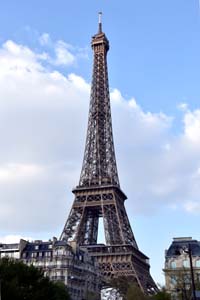 |
| From April 14 to 16, 2019, Daisosho Genshitsu SEN (Daisosho = his title as Urasenke Iemoto Elder, the former Urasenke Iemoto), who has been serving as UNESCO Goodwill Ambassador since March 2012, was in Paris and had his first personal meeting with UNESCO Director-General Audrey Azoulay at UNESCO Headquarters, a meeting which he had been anxious to realize since she assumed her position as Director-General in November, 2017. In conjunction, he conducted a kencha-shiki (tea offering ceremony) at UNESCO Headquarters, in prayer for Global Peace, which was hosted by Japan’s Permanent Delegation to UNESCO. Director-General Azoulay and members of the various Permanent Delegations attended this. While in Paris, Daisosho also took part in a name plaque unveiling ceremony for the "Seiyuan" tea house newly reconstructed at the Vallee-aux-Loups Maison de Chateaubriand. The meeting with Director-General Azoulay, which was followed by the kencha-shiki, took place on April 15. Daisosho was accompanied by Japan’s Permanent Delegate to UNESCO, Ambassador Takio YAMADA, and, at the meeting, Daisosho and the Director-General discussed a range of topics, including the importance of Education, and moral issues which modern man faces as scientific advances move forward. |
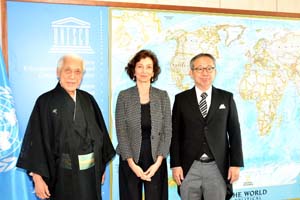 |
| Daisosho, Director-General Azoulay, and Ambassador Yamada take a commemorative photo together |
They then moved to the Garden of Peace (Japanese Garden), designed by American-Japanese sculptor-artist Isamu NOGUCHI in 1958 and donated by the Government of Japan. For this day's kencha-shiki in the garden, a make-shift alcove had been set up, to hang a calligraphic work reading
 or "Waterfall of Harmony," and a tenchaban (tea-preparing table) had been arranged, for Daisosho to prepare the offering. The ceremony began with a speech by H.E. Yamada, describing how the four underlying principles of Japan's chado (way of tea) — Harmony, Respect, Purity, Tranquility — concurred with the principles of the UNESCO mission. He expressed his hope that this day's kencha-shiki event would help to deepen UNESCO's understanding of this spirit of chado. Director-General Azoulay followed with a speech in which she mentioned that Daisosho had presented a chakai (tea gathering) here at the opening of this Garden of Peace in 1958. She went on to say that she felt honored that such a person who shared in the history of UNESCO was there with them now, and she anticipated that the relations between the nations whose representatives were in attendance would be affected in a positive way by the representatives' participation in this chanoyu service. Daisosho then sat at the tenchaban, solemnly prepared a bowl of tea, and placed it on the offering table that stood in front of the alcove and was flanked by the flags of UNESCO and Japan.
or "Waterfall of Harmony," and a tenchaban (tea-preparing table) had been arranged, for Daisosho to prepare the offering. The ceremony began with a speech by H.E. Yamada, describing how the four underlying principles of Japan's chado (way of tea) — Harmony, Respect, Purity, Tranquility — concurred with the principles of the UNESCO mission. He expressed his hope that this day's kencha-shiki event would help to deepen UNESCO's understanding of this spirit of chado. Director-General Azoulay followed with a speech in which she mentioned that Daisosho had presented a chakai (tea gathering) here at the opening of this Garden of Peace in 1958. She went on to say that she felt honored that such a person who shared in the history of UNESCO was there with them now, and she anticipated that the relations between the nations whose representatives were in attendance would be affected in a positive way by the representatives' participation in this chanoyu service. Daisosho then sat at the tenchaban, solemnly prepared a bowl of tea, and placed it on the offering table that stood in front of the alcove and was flanked by the flags of UNESCO and Japan. |
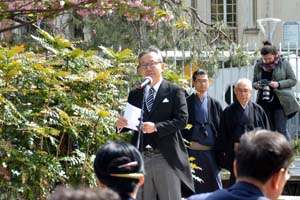 |
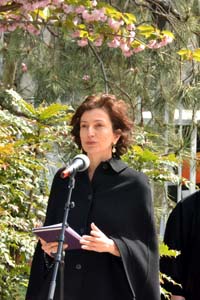 |
| Ambassador Yamada gives opening speech | Director-General Azouley gives speech |
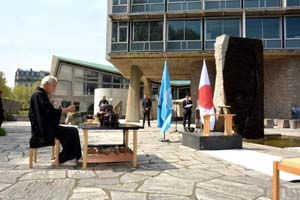 |
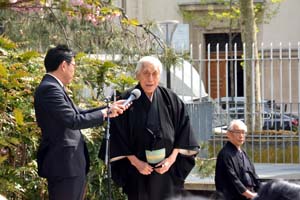 |
| Daisosho prepares the tea offering | Daisosho addresses the attendees |
| After the tea offering, Daisosho addressed the attendees. In connection with the calligraphic work, "Waterfall of Harmony," which represented the particular theme which he wished this day's tea offering to turn attention to, he spoke of the importance of the earth's water, sunshine, and terra firma. He closed by expressing his thanks to all those gathered there, for their Peace activities as people affiliated with UNESCO. Next, the ceremony participants, who numbered approximately thirty, moved to the indoors hall which had been arranged to served them tea. They were joined there by more than two hundred others at UNESCO Headquarters, to be served Japanese tea sweets and usucha (individual bowls of relatively thin-consistency matcha tea). |
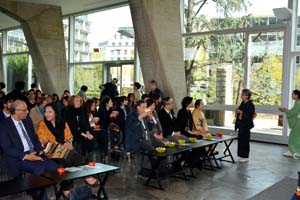 |
| The following day, April 16, the name plaque unveiling ceremony for the newly reconstructed "Seiyuan" tea house took place at the Vallee-aux-Loups Maison de Chateaubriand. The original "Seiyuan" tea house was a contribution made by Daisosho (then Urasenke Iemoto) to the Information and Culture Centre of the Embassy of Japan in Paris in 1985. With the closure of the Center in 2007, the tea house was dismantled and kept in storage at the Embassy. Thanks to the concern, enthusiasm, and concerted efforts of many, it has been brought back to life, as a donation to Hauts-de-Seine, a local department within the inner suburbs of Paris, and been rebuilt within the bonsai arboretum at the Vallee-aux-Loups. The Albert-Kahn museum and gardens, with its traditional Japanese house and tea room which have been a center of Urasenke's activities in Paris, lies in this district. Tentative future plans for the "Seiyuan" are to move it to the Albert-Kahn gardens, and incorporate it into the Japanese complex there, which currently is undergoing reconstruction. Participating in the name plaque unveiling were the President of the Hauts-de-Seine General Council, Patrick DEVEDJIAN, and Japanese Ambassador Masato KITERA. |
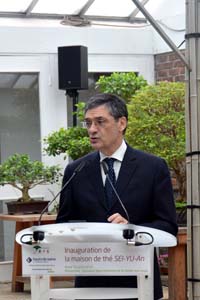 |
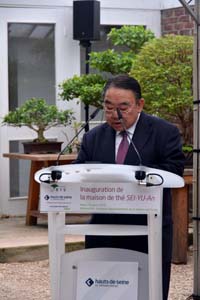 |
| Hauts-de-Seine General Council President, Patrick DEVEDJIAN |
Japanese Ambassador to France Masato KITERA |
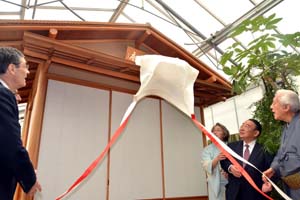 |
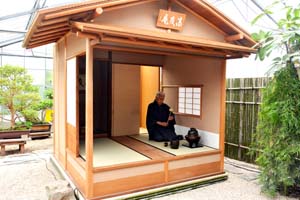 |
| Unveiling the name plaque | Daisosho sits in the Seiyuan and prepares the first bowl of tea, inaugurating the use of the tea house |
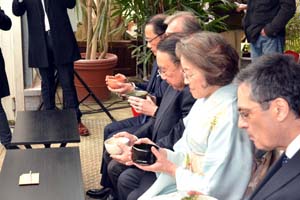 |
| Participants in the unveiling ceremony are served tradition tea sweets and usucha |
| HOME |